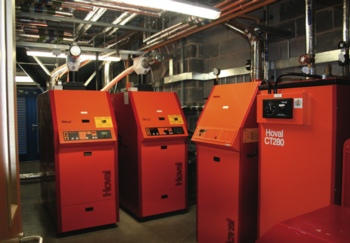Low-carbon meets boilers

It is now very common for projects to use more than one heat source for space heating and domestic hot water. Integration and control are therefore fundamental to the system design, says Kevin Stones.
The ongoing importance of reducing energy consumption and carbon emissions has led to many more projects opting for a combination of different heat sources, not just a boiler — often mixing traditional and low-carbon sources. In fact, planning consent and the desire to score well in BREEAM/LEED schemes etc. will often necessitate a proportion of low-carbon heating in the design.
The result is that building-services specifiers need to pay very close attention to how they integrate and control these heat sources in relation to the heat-load patterns of each project.
For example, combined heat and power (CHP) is currently enjoying a resurgence of interest in projects ranging from town centres to relatively small housing developments.
In such cases, the CHP engine will often be combined with different types of boilers. A typical scenario might be to size the CHP engine on its thermal output to meet the constant base heat load throughout the year.
It will then be necessary to make provision for higher base loads in colder weather and peak heat loads at different times of day. The winter base load may be met with a biomass boiler to take advantage of the high efficiencies of modern biomass boilers at relatively constant loads — as well as the extra revenue from the Renewable Heat Incentive (RHI).
The design may also recognise that while biomass boilers cope well with variable heat loads, they perhaps do not do this as efficiently as a gas-fired condensing boiler — so the latter may be the best option for meeting peak loads with maximum efficiency.
Of course, CHP and biomass will not always be the most appropriate low-carbon heat sources and solar-thermal systems are also proving popular — again partly driven by the RHI. There may also be scope for heat pumps. However air-source heat pumps are not included in the RHI, and ground-source heat pumps can be costly to install, leading to a longer payback period.
The key issue with solar thermal and heat pumps is the seasonal variation in heating capacity, so there will always be a requirement for a suitable level of back-up in the system. This, in turn, may impact on capital costs and return on investment calculations.
It is important to ensure that each heat source is used to optimum effect, so control aspects are very important. For example, solar-thermal systems and heat pumps are often used to pre-heat cold water for hot-water systems, with other heat sources (e.g. gas, oil or biomass boilers) being used to bring the water up to the required temperature and for pasteurisation cycles. This approach tends to work well and increases efficiency by minimising the use of the boiler plant. However, it is essential to include effective controls and suitably designed thermal-storage vessels to ensure that each type of heat source is used to optimum effect.

Other situations may point to a different solution. Swimming pools, for example, act as a large heat sink with relatively low operating temperatures (typically 26 to 30°C) that can easily be achieved with solar thermal, with no need to buy thermal-storage vessels. These low temperatures result in high collector efficiencies and solar fractions. Additionally most indoor pools have a large roof area, which is ideal for the solar collectors.
Designing for lower water temperatures
Where existing heating plant is being replaced or additional plant is being added, the flexibility for the specifier will often be limited by the nature of the heat emitters in the space-heating system. This is one of the reasons why biomass boilers are currently proving so popular, as they generally deliver hot water at around 82°C, equivalent to conventional boilers.
With new-build projects the situation is different, as the building fabric should be playing a key role in reducing space-heating requirements, and heat emitters can be selected for use with lower hot-water flow temperatures. This opens the door for lower-grade heat sources and also results in lower return-water temperatures (compared to a traditional system), so condensing boilers may be the best choice as a back-up heat source.
Maintaining efficiency
Ongoing system efficiency is also important, so plant should be maintained regularly and control strategies should be re-evaluated regularly to ensure they reflect the way the building is being used. This is best achieved by using maintenance engineers with specialist expertise in this area.
Ultimately, the key to arriving at the best solution is to decide which renewable and conventional heat sources will work together in a controllable fashion. Further, these choices need to be made in the context of the nature of the building and how it is used on a day-to-day basis, local planning requirements, the building owner’s aspirations and the budgetary realities.
Kevin Stones is engineering and service director with Hoval.







